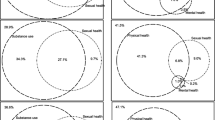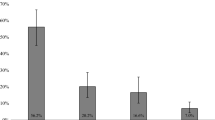Abstract
Participation in the workplace has been proposed as a potential structural-level HIV/STI prevention strategy for youth. Only a few cross-sectional studies have explored the effect of work during adolescence and young adulthood on sexual behavior and their results have been mixed. This study builds on this literature by exploring whether work influences youths’ sexual behavior in a cohort of African American youth (N = 562; 45% males; M = 14.5 years, SD = 0.6) followed from adolescence to young adulthood (ages 13–25 years). Using growth curve modeling, we tested whether working was associated with older sex partners. Then, we explored the association between sex partner age differences and sexual behaviors (i.e., number of sex partners, condom use, and frequency of sexual intercourse). Finally, we tested whether the relationship between sex partner age differences and sexual behaviors was confounded by working. Working greater number of hours was not significantly associated with having older sex partners. Sex partner age differences was associated with number of partners, condom use, and higher sex frequency. These associations were larger for females. Working was associated with higher sex frequency, after accounting for age differences. We discuss the implications of these findings for future research and program planning, particularly in the context of youth development programs.





Similar content being viewed by others
References
Anderson, J. E., Brackbill, R., & Mosher, W. D. (1996). Condom use for disease prevention among unmarried US women. Family Planning Perspectives, 28, 25–28.
Bauermeister, J. A., Zimmerman, M. A., Barnett, T., & Caldwell, C. (2007). Working in high school and the transition to adulthood among African American youth. Journal of Youth and Adolescence, 36, 877–890.
Brewster, L. K. (1994). Neighborhood context and the transition to sexual activity among young black women. Demography, 31, 603–614.
Centers for Disease Control and Prevention. (2005). 2004 HIV/AIDS Surveillance Report (Vol. 16). Atlanta: US Department of Health and Human Services, Centers for Disease Control and Prevention.
Cohen, J., Cohen, P., West, S. G., & Aiken, L. (2002). Applied multiple regression/correlation analysis for the behavioral sciences (3rd ed.). Mahwah, NJ: Lawrence Erlbaum Associates.
Connell, R. W. (1987). Gender and power. Stanford, CA: Stanford University Press.
Coverdill, J. E., & Kraft, J. M. (1996). Enrollment, employment, and the risk and resolution of a first premarital pregnancy. Social Science Quarterly, 77, 43–59.
DiClemente, R. J., Wingood, G. M., Sionean, C., Crosby, R. A., Harrington, K., Davies, S., et al. (2002). Association of adolescents’ history of sexually transmitted disease (STD) and their current high-risk behavior and STD status: A case for intensifying clinic-based prevention efforts. Sexually Transmitted Diseases, 29, 503–510.
Ford, K., & Lepkowski, J. M. (2004). Characteristics of sexual partners and STD infection among American adolescents. International Journal of STD & AIDS, 15, 260–265.
Geronimus, A. T. (2001). Understanding and eliminating racial inequalities in women’s health in the United States: The role of the weathering conceptual framework. Journal of the American Medical Women’s Association, 56, 133–136.
Geronimus, A. T., Bound, J., & Waidmann, T. A. (1999). Health inequality and population variation in fertility-timing. Social Science and Medicine, 49, 1623–1636.
Greenberger, E., & Steinberg, L. (1986). When teenagers work: The psychological and social costs of adolescent employment. New York: Basic Books.
Greig, F. E., & Koopman, C. K. (2003). Multilevel analysis of women’s empowerment and HIV prevention: Quantitative survey results from a Preliminary Study I Botswana. AIDS & Behavior, 7, 195–208.
Hall, E. (1991). Gender, work control and stress: A theoretical discussion and an empirical test. In J. V. Johnson & G. Johansson (Eds.), The psychosocial work environment: Work organization, democratization and health (pp. 89–108). Amityville, NY: Baywood.
Kaestle, C. E., Morisky, D. E., & Wiley, D. J. (2002). Sexual intercourse and the age difference between adolescent women and their romantic partners. Perspectives on Sexual and Reproductive Health, 34, 304–309.
Kraft, J. M., & Coverdill, J. E. (1994). Employment and the use of birth control by sexually active single Hispanic, Black, and White women. Demography, 31, 593–602.
Link, B. G., & Phelan, J. (2003). Social conditions as fundamental causes of disease. Journal of Health and Social Behavior, 35, 80–94.
MacKinnon, D. P., Warsi, G., & Dwyer, J. H. (1995a). A simulation study of mediated effect measures. Multivariate Behavioral Research, 30, 41–62.
MacKinnon, D. P., Warsi, G., & Dwyer, J. H. (1995b). A simulation study of mediated effect measures: Erratum. Multivariate Behavioral Research, 30(3), ii.
Mortimer, J. T. (2003). Work and growing up in America. Cambridge, MA: Harvard University Press.
Oakes, J. M., & Rossi, P. H. (2003). The measurement of SES in health research: Current practice and steps toward a new approach. Social Science & Medicine, 56, 769–784.
Raudenbush, S. W., & Bryk, A. S. (2002). Hierarchical linear models: Applications and data analysis methods (2nd ed.). Thousand Oaks, CA: Sage Publications.
Rich, L. M., & Kim, S. B. (2002). Employment and the sexual and reproductive behavior of female adolescents. Perspectives on Sexual and Reproductive Health, 34, 127–134.
Sandfort, T., Orr, M., Hirsch, J. S., & Santelli, J. (2008). Long-term health correlates of timing of sexual debut: Results from a national US study. American Journal of Public Health, 98, 155–161.
Scientific Software International. (2005). Hierarchical linear models (version 6.01). Chicago: SSI Inc.
Shelton, J. D., Cassell, M. M., & Adetunji, J. (2005). Is poverty or wealth at the root of HIV? Lancet, 366, 1057–1058.
Sherman, S. G., German, Y., Cheng, M., Marks, M., & Bailey-Kloche, M. (2006). The evaluation of the JEWEL project: An innovative economic enhancement and HIV prevention intervention study targeting drug using females involved in prostitution. AIDS Care, 18, 1–11.
Silbereisen, R. K., & Kracke, B. (1997). Self-reported maturational timing and adaptation in adolescence. In J. Schulenberg, J. L. Maggs, & K. Hurrelmann (Eds.), Health risks and developmental transitions during adolescence (pp. 85–109). New York: Cambridge University Press.
Staff, J., Mortimer, J. T., & Uggen, C. (2004). Work and leisure in adolescence. In R. M. Lerner & L. Steinberg (Eds.), Handbook of adolescent psychology (2nd ed., pp. 429–450). Hoboken, NJ: Wiley.
U.S. Department of Labor Bureau of Labor Statistics. (2004). The employment situation: June 2004. http://www.bls.gov/news.release/pdf/empsit.pdf. Accessed 8 July 2004.
Valleroy, L. A., MacKellar, D. A., Karon, J. M., Janssen, R. S., & Hayman, C. R. (1998). HIV infection in disadvantaged out-of-school youth: Prevalence for U.S. Job Corps entrants, 1990 through 1996. Journal of the Acquired Immune Deficiency Syndrome and Human Retrovirology, 19, 67–73.
Wingood, G. M., & DiClemente, R. J. (1998). Relationship characteristics associated with noncondom use among young adult African American women. American Journal of Community Psychology, 26, 29–53.
Wingood, G. M., & DiClemente, R. J. (2002). The theory of gender and power: A social structural theory for guiding public health interventions. In R. J. DiClemente, R. A. Crosby, & M. C. Kegler (Eds.), Emerging theories in health promotion practice and research: Strategies for improving public health (pp. 313–346). San Francisco: Jossey-Bass.
Zimmerman, M. A., Caldwell, C. H., & Bernat, D. H. (2002). Discrepancy between self-report and school-record grade point average: Correlates with psychosocial outcomes among African American adolescents. Journal of Applied Social Psychology, 32, 86–109.
Acknowledgments
This research was supported by a grant from the National Institute of Drug Abuse to the University of Michigan School of Public Health (Grant Number R01-DA07484; Principal Investigator: Marc A. Zimmerman, Ph.D.) and a training grant from the National Institute of Mental Health to the HIV Center for Clinical and Behavioral Studies at New York State Psychiatric Institute and Columbia University (T32-MH19139 Behavioral Sciences Research in HIV Prevention; Principal Investigator, Anke A. Ehrhardt, Ph.D.).
Author information
Authors and Affiliations
Corresponding author
Rights and permissions
About this article
Cite this article
Bauermeister, J.A., Zimmerman, M., Xue, Y. et al. Working, Sex Partner Age Differences, and Sexual Behavior among African American Youth. Arch Sex Behav 38, 802–813 (2009). https://doi.org/10.1007/s10508-008-9376-3
Received:
Revised:
Accepted:
Published:
Issue Date:
DOI: https://doi.org/10.1007/s10508-008-9376-3




